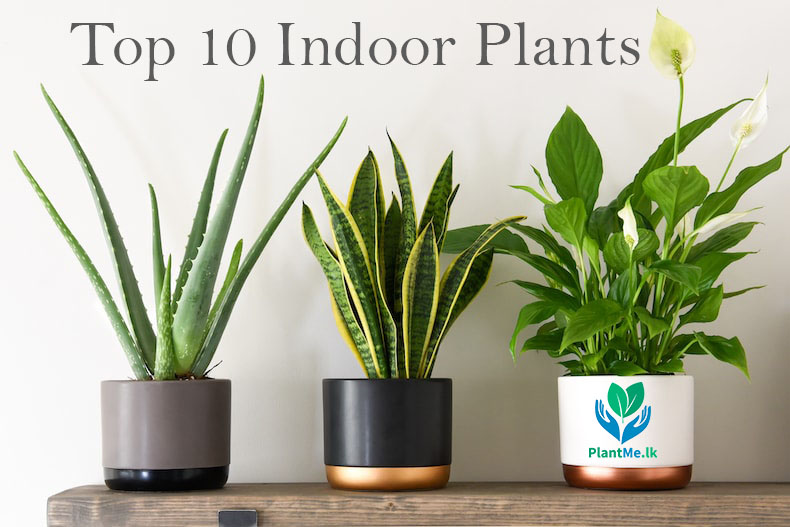Indoor Plants
Top 10 indoor plants in the World – Top Plants
There are many indoor plants that are well-suited to growing indoors, and the top plants will vary depending on personal preference and growing conditions. Some popular options for indoor plants include:
1. Snake plant

The Snake plant, also known as the Sansevieria or mother-in-law’s tongue, is a popular choice for indoor gardening. It is a tough, resilient plant native to West Africa that is known for its ability to thrive in a variety of conditions. With its upright, sword-like foliage, the Snake plant has a striking appearance that adds a touch of sophistication to any space.
One of the most appealing aspects of the Snake plant is its low maintenance requirements. It is able to tolerate low light levels, infrequent watering, and a range of temperatures, making it perfect for busy individuals who may not have a lot of time to devote to plant care. Additionally, Snake plants are known for their ability to purify the air, making them a great choice for improving indoor air quality.
In terms of care, Snake plants are very forgiving. They prefer well-draining soil and should be watered only when the soil has completely dried out. Over-watering can be a problem for Snake plants, so it is important to check the soil moisture levels before watering. They also prefer indirect light and good air circulation, so be sure to place your Snake plant in an area that meets these requirements.
Overall, the Snake plant is a hardy and low maintenance choice for indoor gardening. Its striking foliage and air-purifying abilities make it a great addition to any home.
How to Grow Snake Plant?
- Choose a pot with drainage holes and fill it with a well-draining potting mix. Snake plants prefer soil that is slightly on the dry side.
- Plant your Snake plant in the pot and place it in an area that receives indirect light. Avoid direct sunlight, as this can scorch the leaves.
- Water your Snake plant sparingly. Allow the soil to dry out completely before watering again. Over-watering can be a problem for Snake plants, so be sure to check the soil moisture levels before watering.
- Provide good air circulation for your Snake plant. Place it in an area with good air flow, and avoid placing it near heaters or air conditioning vents.
2. Philodendron
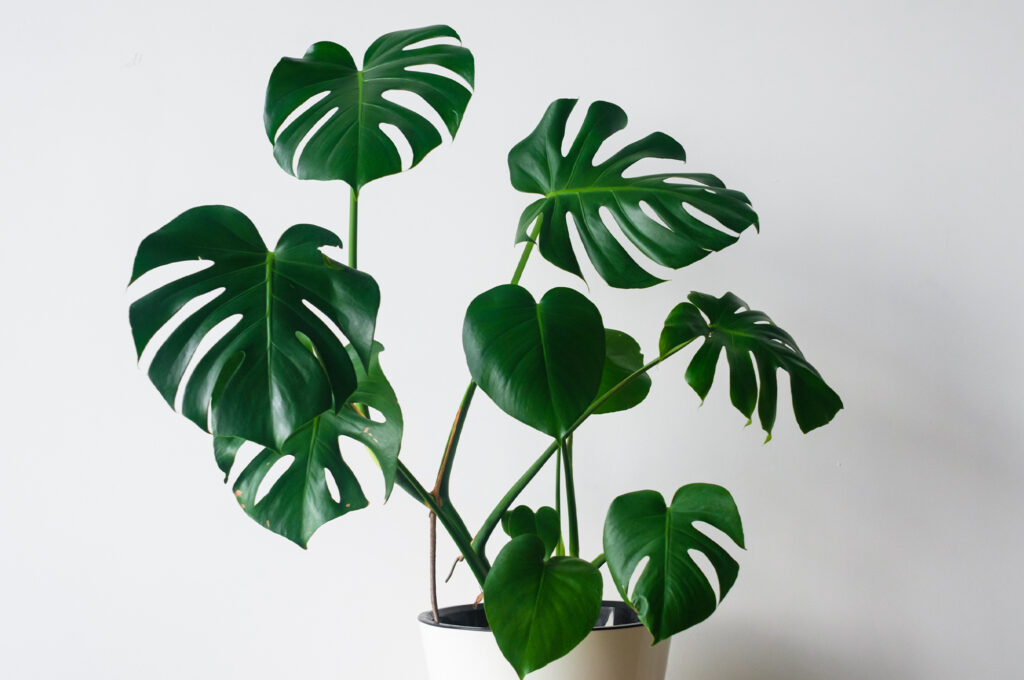
Philodendron is a large genus of flowering plants native to the Americas. They are a popular choice for indoor gardening due to their attractive, heart-shaped leaves and their ability to thrive in a variety of conditions.
There are many different varieties of Philodendron, ranging from small, low-growing plants to large, climbing vines. The most common type of Philodendron for indoor use is the heartleaf Philodendron, which has long, slender leaves that are dark green in color.
In terms of care, Philodendron plants prefer indirect light and well-draining soil. They should be watered regularly, but allow the soil to dry out slightly between watering. Over-watering can be a problem for Philodendron plants, so be sure to check the soil moisture levels before watering.
Overall, Philodendron plants are a popular choice for indoor gardening due to their attractive foliage and low maintenance requirements. With proper care, they can add a touch of nature to any home.
How to Grow Philodendron?
- Choose a pot with drainage holes and fill it with a well-draining potting mix. Philodendron plants prefer soil that is slightly on the moist side.
- Plant your Philodendron in the pot and place it in an area that receives indirect light. Avoid direct sunlight, as this can scorch the leaves.
- Water your Philodendron regularly, allowing the soil to dry out slightly between watering. Over-watering can be a problem for Philodendron plants, so be sure to check the soil moisture levels before watering.
- Provide good air circulation for your Philodendron. Place it in an area with good air flow, and avoid placing it near heaters or air conditioning vents.
- Trim off any yellow or brown leaves to keep the plant looking healthy.
- Fertilize your Philodendron every two to three weeks during the growing season.
- Keep the plant at a consistent temperature, avoiding sudden changes in temperature.
- Repot the plant every two to three years, or when it outgrows its current pot.
3. Spider plant

The Spider plant, also known as the Airplane plant or St. Bernard’s lily, is a popular choice for indoor gardening. It is a tough, resilient plant that is native to South Africa and is known for its ability to thrive in a variety of conditions.
The Spider plant is a low-growing plant that is characterized by its long, thin leaves that are striped with white or yellow variegation. As the plant matures, it produces small white flowers that give way to baby Spider plants, which dangle from the mother plant on thin stems. These baby plants can be easily removed and propagated to create new Spider plants.
In terms of care, Spider plants are very easy to grow. They prefer well-draining soil and should be watered regularly, allowing the soil to dry out slightly between watering. They also prefer indirect light and good air circulation, so be sure to place your Spider plant in an area that meets these requirements.
Overall, the Spider plant is a hardy and low maintenance choice for indoor gardening. Its attractive foliage and ability to reproduce easily make it a great addition to any home.
How to Grow Spider Plant?
- Choose a pot with drainage holes and fill it with a well-draining potting mix.
- Plant your Spider plant in the pot and place it in an area that receives indirect light.
- Water your Spider plant regularly, allowing the soil to dry out slightly between watering.
- Provide good air circulation for your Spider plant.
- Trim off any yellow or brown leaves to keep the plant looking healthy.
- Fertilize your Spider plant every two to three weeks during the growing season.
- Keep the plant at a consistent temperature, avoiding sudden changes in temperature.
- Check the soil moisture levels before watering to prevent over-watering.
- Repot the plant every two to three years, or when it outgrows its current pot.
- Propagate baby Spider plants by carefully removing them from the mother plant and planting them in their own pots.
4. Pothos
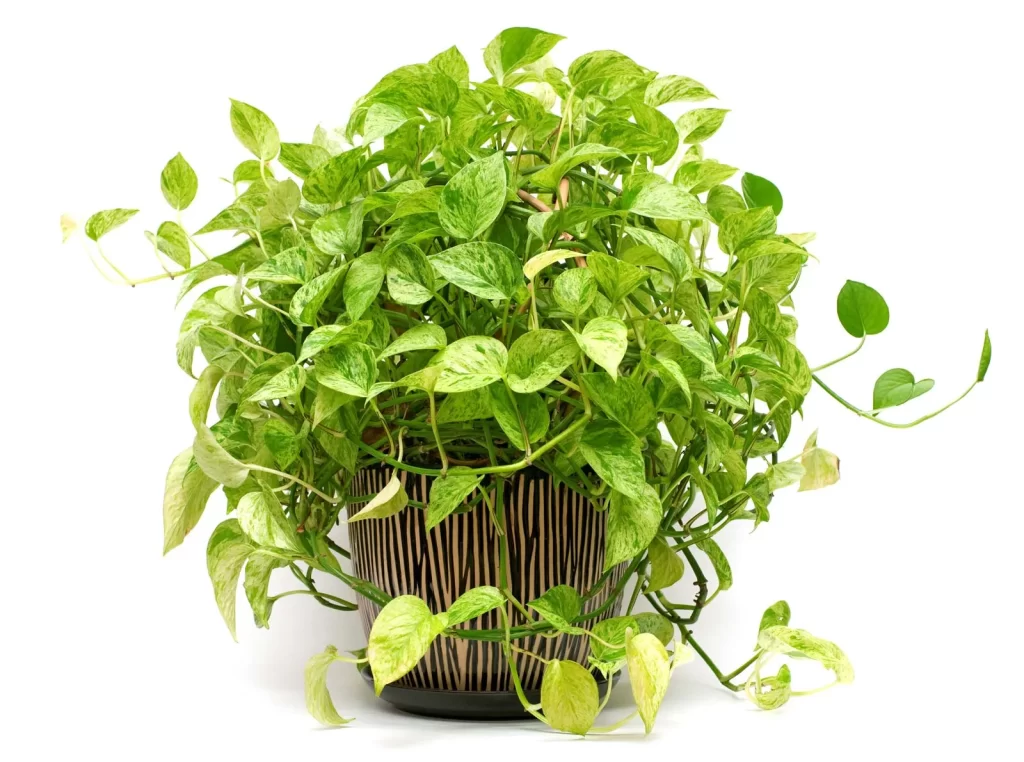
Pothos, also known as Devil’s Ivy, is a popular choice for indoor gardening. It is a fast-growing, resilient plant that is native to the Solomon Islands and is known for its ability to thrive in a variety of conditions.
Pothos plants are characterized by their long, heart-shaped leaves that are variegated with shades of green, yellow, and white. They are easy to care for and are a popular choice for beginners because of their low maintenance requirements.
In terms of care, Pothos plants prefer indirect light and well-draining soil. They should be watered regularly, allowing the soil to dry out slightly between watering. Over-watering can be a problem for Pothos plants, so be sure to check the soil moisture levels before watering.
Pothos plants are also known for their air-purifying abilities, making them a great choice for improving indoor air quality. They are also easy to propagate, allowing you to create new plants from cuttings.
Overall, Pothos plants are a popular choice for indoor gardening due to their attractive foliage and low maintenance requirements. With proper care, they can add a touch of nature to any home.
How to Grow Pothos?
- Choose a pot with drainage holes and fill it with a well-draining potting mix. Pothos plants prefer soil that is slightly on the moist side.
- Plant your Pothos in the pot and place it in an area that receives indirect light. Avoid direct sunlight, as this can scorch the leaves.
- Water your Pothos regularly, allowing the soil to dry out slightly between watering. Over-watering can be a problem for Pothos plants, so be sure to check the soil moisture levels before watering.
- With proper care, your Pothos plant will thrive and bring a touch of nature to your living space. As the plant matures, it can be easily propagated to create new plants.
5. ZZ plant
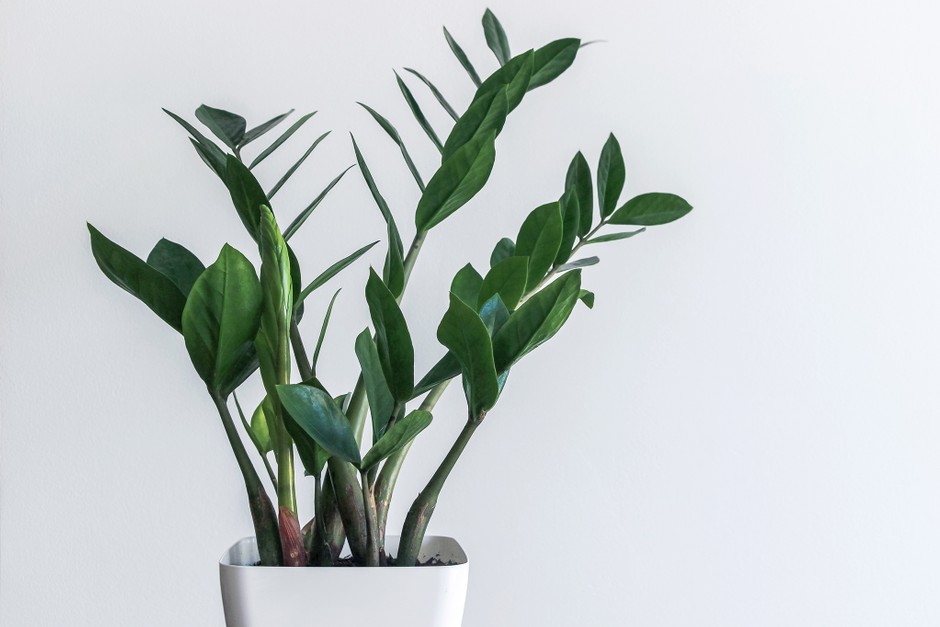
The ZZ plant, also known as the Zamioculcas zamiifolia, is a popular choice for indoor gardening. It is a tough, resilient plant native to eastern Africa that is known for its ability to thrive in a variety of conditions.
The ZZ plant is characterized by its glossy, dark green leaves that are arranged in a spiral pattern on thick, upright stems. It is a slow-growing plant that is perfect for busy individuals who may not have a lot of time to devote to plant care.
In terms of care, the ZZ plant is very easy to grow. It prefers well-draining soil and should be watered only when the soil has completely dried out. Over-watering can be a problem for ZZ plants, so it is important to check the soil moisture levels before watering. They also prefer indirect light and good air circulation, so be sure to place your ZZ plant in an area that meets these requirements.
Overall, the ZZ plant is a hardy and low maintenance choice for indoor gardening. Its attractive foliage and ability to thrive in a variety of conditions make it a great addition to any home.
How to Grow ZZ Plant?
- Choose a pot with drainage holes and fill it with a well-draining potting mix. ZZ plants prefer soil that is slightly on the dry side.
- Plant your ZZ plant in the pot and place it in an area that receives indirect light. Avoid direct sunlight, as this can scorch the leaves.
- Water your ZZ plant sparingly. Allow the soil to dry out completely before watering again. Over-watering can be a problem for ZZ plants, so be sure to check the soil moisture levels before watering.
- Provide good air circulation for your ZZ plant. Place it in an area with good air flow, and avoid placing it near heaters or air conditioning vents.
- Trim off any yellow or brown leaves to keep the plant looking healthy.
- Fertilize your ZZ plant every two to three months during the growing season.
6. Peace Lily
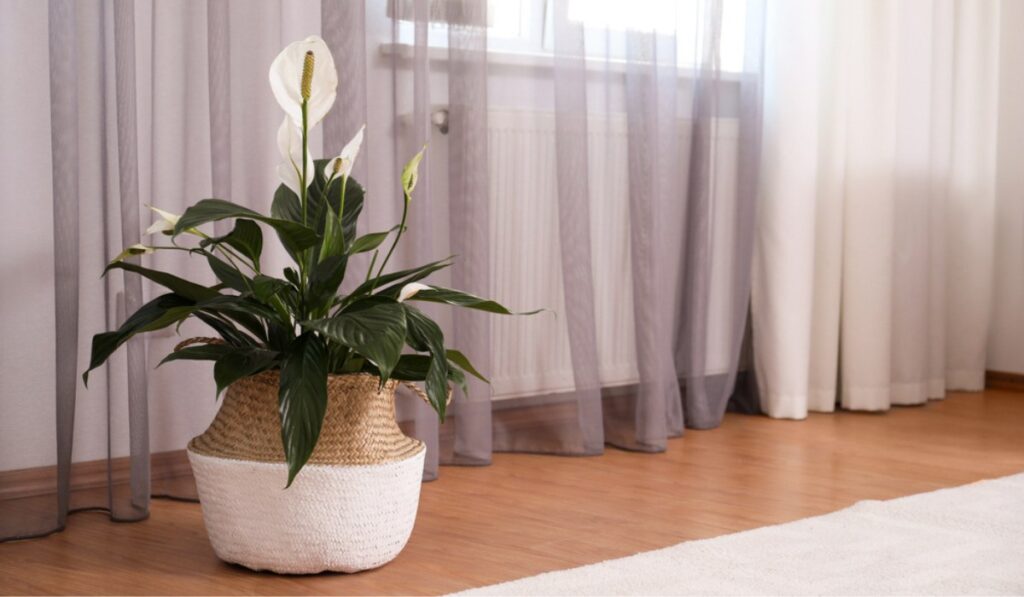
The Peace Lily, also known as the Spathiphyllum, is a popular choice for indoor gardening. It is a tropical plant native to South and Central America that is known for its elegant, white flowers and its ability to thrive in low light conditions.
Peace Lilies are characterized by their glossy, dark green leaves and their distinctive white flowers that emerge from a white, hood-like spathe. They are a low-maintenance plant that is easy to care for, making them a popular choice for busy individuals or those new to indoor gardening.
In terms of care, Peace Lilies prefer well-draining soil and should be watered regularly, allowing the soil to dry out slightly between watering. Over-watering can be a problem for Peace Lilies, so be sure to check the soil moisture levels before watering. They also prefer indirect light and good air circulation, so be sure to place your Peace Lily in an area that meets these requirements.
Overall, the Peace Lily is a beautiful and low-maintenance choice for indoor gardening. Its elegant flowers and ability to thrive in low light conditions make it a great addition to any home.
How to Grow Peace Lily?
- Choose a pot with drainage holes and fill it with a well-draining potting mix. Peace Lilies prefer soil that is slightly on the moist side.
- Plant your Peace Lily in the pot and place it in an area that receives indirect light. Avoid direct sunlight, as this can scorch the leaves.
- Water your Peace Lily regularly, allowing the soil to dry out slightly between watering. Over-watering can be a problem for Peace Lilies, so be sure to check the soil moisture levels before watering.
- Provide good air circulation for your Peace Lily. Place it in an area with good air flow, and avoid placing it near heaters or air conditioning vents.
- Trim off any yellow or brown leaves to keep the plant looking healthy.
- Fertilize your Peace Lily every two to three months during the growing season.
- Keep the plant at a consistent temperature, avoiding sudden changes in temperature.
- Repot the plant every two to three years, or when it outgrows its current pot.
- Prune the plant to encourage new growth and maintain its shape.
- Once the plant is mature, it will produce white flowers on tall stalks. These flowers can be cut and placed in a vase for a beautiful display.
7. Rubber Plant
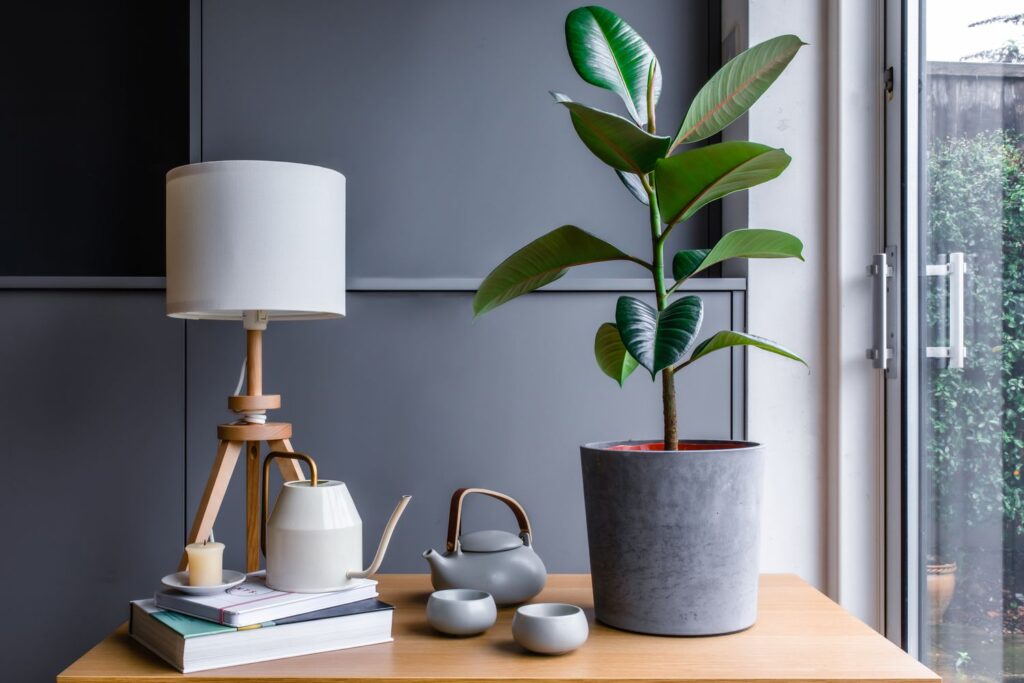
The Rubber Plant, also known as the Ficus elastica, is a popular choice for indoor gardening. It is a tropical plant native to India and Malaysia that is known for its glossy, dark green leaves and its ability to thrive in low light conditions.
Rubber Plants are characterized by their large, oval-shaped leaves that are glossy and dark green in color. They are a fast-growing plant that can reach heights of up to 10 feet when grown indoors.
In terms of care, Rubber Plants prefer well-draining soil and should be watered regularly, allowing the soil to dry out slightly between watering. Over-watering can be a problem for Rubber Plants, so be sure to check the soil moisture levels before watering. They also prefer indirect light and good air circulation, so be sure to place your Rubber Plant in an area that meets these requirements.
Overall, the Rubber Plant is a beautiful and low-maintenance choice for indoor gardening. Its glossy leaves and ability to thrive in low light conditions make it a great addition to any home.
How to Grow Rubber Plant?
- Choose a pot with drainage holes and fill it with a well-draining potting mix. Rubber Plants prefer soil that is slightly on the moist side.
- Plant your Rubber Plant in the pot and place it in an area that receives indirect light. Avoid direct sunlight, as this can scorch the leaves.
- Water your Rubber Plant regularly, allowing the soil to dry out slightly between watering. Over-watering can be a problem for Rubber Plants, so be sure to check the soil moisture levels before watering.
- Provide good air circulation for your Rubber Plant. Place it in an area with good air flow, and avoid placing it near heaters or air conditioning vents.
- Trim off any yellow or brown leaves to keep the plant looking healthy.
- Fertilize your Rubber Plant every two to three months during the growing season.
- Repot the plant every two to three years, or when it outgrows its current pot.
- With proper care, your Rubber Plant will thrive and bring a touch of nature to your living space. Its glossy, dark green leaves will add a touch of elegance to any room. As the plant matures, it will grow to its full height, producing large, impressive leaves.
8. Ficus
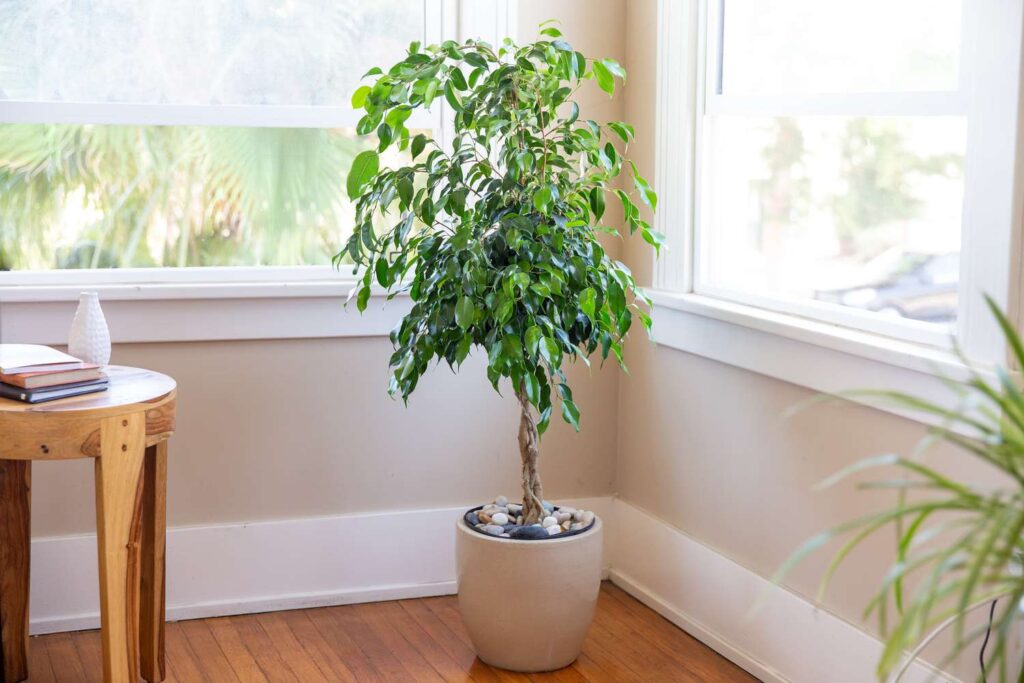
Ficus, also known as the Fig plant, is a popular choice for indoor gardening. It is a tropical plant that is native to India, Southeast Asia, and Australia. There are over 800 species of Ficus plants, many of which are popular as houseplants due to their low maintenance requirements and their ability to thrive in a variety of conditions.
Ficus plants are characterized by their glossy, dark green leaves and their unique growth habits. Some species, such as the Ficus benjamina, have a weeping growth habit, while others, such as the Ficus elastica, have a more upright growth habit.
In terms of care, Ficus plants prefer well-draining soil and should be watered regularly, allowing the soil to dry out slightly between watering. Over-watering can be a problem for Ficus plants, so be sure to check the soil moisture levels before watering. They also prefer indirect light and good air circulation, so be sure to place your Ficus plant in an area that meets these requirements.
Overall, Ficus plants are a popular choice for indoor gardening due to their attractive foliage and low maintenance requirements. With proper care, they can add a touch of nature to any home.
How to Grow Ficus?
- Choose a pot with drainage holes and fill it with a well-draining potting mix. Ficus plants prefer soil that is slightly on the moist side.
- Plant your Ficus in the pot and place it in an area that receives indirect light. Avoid direct sunlight, as this can scorch the leaves.
- Water your Ficus regularly, allowing the soil to dry out slightly between watering. Over-watering can be a problem for Ficus plants, so be sure to check the soil moisture levels before watering.
- Provide good air circulation for your Ficus. Place it in an area with good air flow, and avoid placing it near heaters or air conditioning vents.
- Trim off any yellow or brown leaves to keep the plant looking healthy.
- Fertilize your Ficus every two to three months during the growing season.
- With proper care, your Ficus will thrive and bring a touch of nature to your living space. As the plant matures, it will produce large, glossy leaves that will create a beautiful bush of foliage.
9. Jade Plant
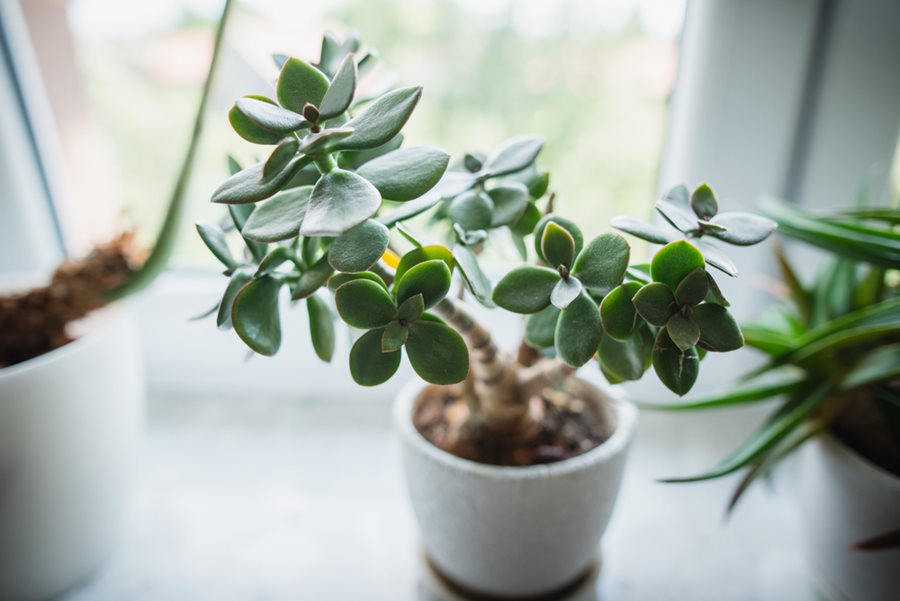
The Jade Plant, also known as the Crassula ovata, is a popular choice for indoor gardening. It is a succulent plant native to South Africa that is known for its ability to store water in its thick, fleshy leaves and stems.
Jade Plants are characterized by their thick, glossy leaves that are arranged in a neat, symmetrical pattern. They are a slow-growing plant that is easy to care for and is known for its ability to withstand long periods of drought.
In terms of care, Jade Plants prefer well-draining soil and should be watered sparingly, allowing the soil to dry out completely between watering. Over-watering can be a problem for Jade Plants, so be sure to check the soil moisture levels before watering. They also prefer indirect light and good air circulation, so be sure to place your Jade Plant in an area that meets these requirements.
Overall, the Jade Plant is a hardy and low-maintenance choice for indoor gardening. Its attractive foliage and ability to withstand drought make it a great addition to any home.
How to Grow Jade Plant?
- Choose a pot with drainage holes and fill it with a well-draining potting mix. Jade Plants prefer soil that is slightly on the dry side.
- Plant your Jade Plant in the pot and place it in an area that receives indirect light. Avoid direct sunlight, as this can scorch the leaves.
- Water your Jade Plant sparingly. Allow the soil to dry out completely before watering again. Over-watering can be a problem for Jade Plants, so be sure to check the soil moisture levels before watering.
- Provide good air circulation for your Jade Plant. Place it in an area with good air flow, and avoid placing it near heaters or air conditioning vents.
- Repot the plant every two to three years, or when it outgrows its current pot. This will provide the plant with fresh soil and more room to grow.
- With proper care, your Jade Plant will thrive and grow to become a large, impressive specimen. Its thick, glossy leaves will add a touch of elegance to any room.
10. English ivy

English ivy, also known as Hedera helix, is a popular choice for indoor gardening. It is a fast-growing, climbing vine that is native to Europe and is known for its ability to thrive in a variety of conditions.
English ivy plants are characterized by their glossy, dark green leaves that are arranged in a distinctive, three-leaf pattern. They are a low-maintenance plant that is easy to care for and is known for their ability to improve indoor air quality.
In terms of care, English ivy plants prefer well-draining soil and should be watered regularly, allowing the soil to dry out slightly between watering. Over-watering can be a problem for English ivy plants, so be sure to check the soil moisture levels before watering. They also prefer indirect light and good air circulation, so be sure to place your English ivy plant in an area that meets these requirements.
Overall, English ivy plants are a popular choice for indoor gardening due to their attractive foliage and low maintenance requirements. With proper care, they can add a touch of nature to any home.
How to Grow English ivy?
- Choose a pot with drainage holes and fill it with a well-draining potting mix. English Ivy plants prefer soil that is slightly on the moist side.
- Plant your English Ivy in the pot and place it in an area that receives indirect light. Avoid direct sunlight, as this can scorch the leaves.
- Water your English Ivy regularly, allowing the soil to dry out slightly between watering. Over-watering can be a problem for English Ivy plants, so be sure to check the soil moisture levels before watering.
- Provide good air circulation for your English Ivy. Place it in an area with good air flow, and avoid placing it near heaters or air conditioning vents.
- Prune the plant regularly to encourage new growth and maintain its shape.
- As the plant matures, it will produce long, trailing vines that can be trained to climb a trellis or other support.
- With proper care, your English Ivy plant will thrive and produce long, beautiful vines. Its glossy, dark green leaves will add a touch of elegance to any room.
These plants are generally easy to care for and can tolerate a range of lighting conditions, making them well-suited to growing indoors. They can also help to purify the air and improve the overall atmosphere of a space.
There are many reasons why we should love indoor plants. First and foremost, they bring a touch of nature into our living spaces, providing us with a connection to the outdoors. Indoor plants can also improve the air quality in our homes, removing toxins and pollutants from the air. In addition, they can add a touch of beauty and elegance to any room.
Indoor plants are also low-maintenance and easy to care for, making them a great option for busy individuals or those new to gardening. They can thrive in a variety of conditions, from low light to high humidity, making them a versatile option for any home.
Overall, indoor plants are a wonderful addition to any home. They bring a touch of nature indoors, improve air quality, and add beauty and elegance to any space.

